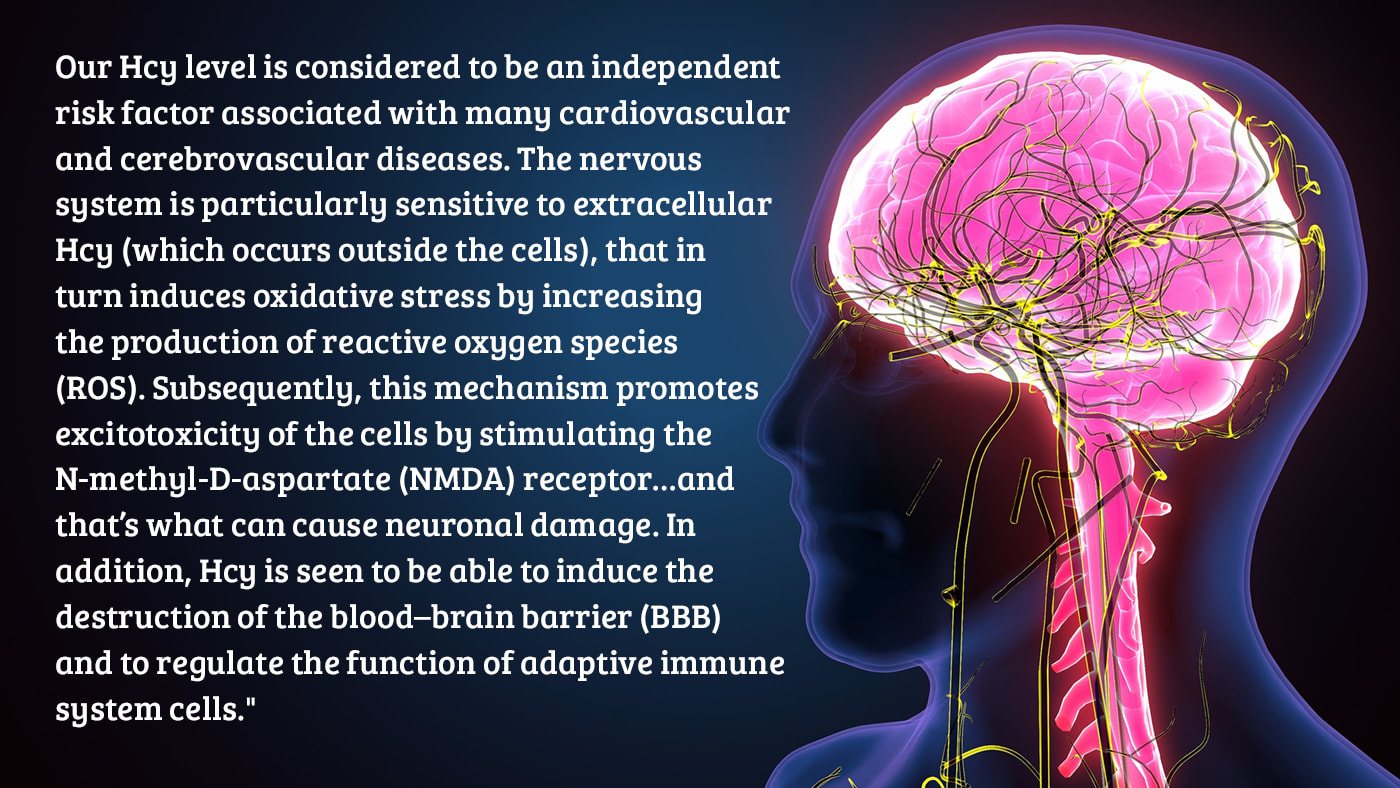|
With all of this information about the role of Hcy and its levels in our bodies, we can see how an interruption in healthy levels can wreak havoc with our normal functions and result in disease initiation.
For example, Hcy levels in patients with multiple sclerosis was higher than that of healthy people, and this “hyperhomocysteinemia” may be related to disease progression and disability severity in patients with multiple sclerosis. Other neurological disorders that may be impacted by high Hcy were examined in this study involving neuromyelitis optica spectrum disorders (NMOSD), a rare antibody-mediated or autoimmune disease of the central nervous system (CNS) that causes inflammation in the spinal cord, optic neuritis and other symptoms. Researchers found that in patients experiencing a first attack of NMOSD that when the serum Hcy level was higher than 14.525 μmol/l, the risk of relapse was high. This suggests that in clinical practice, if we can reduce Hcy levels below the target value with administration of supplementary vitamin B12 and folic acid, it may be possible to improve the prognosis of NMOSD and also reduce the risk of relapse; as such, the investigators noted that this could also be used as a potential treatment strategy for NMOSD.2 But how can we address higher levels of homocysteine? First, it’s important to note that at present, there is no general consensus about the upper reference limits for plasma homocysteine concentrations. Among seemingly healthy individuals, “normal” concentrations commonly range from 5 to 15µmol/L (micromole per liter). However, studies on targeted segments of the population have shown that the upper limit of 15µmol/L is far too high in well-nourished populations without obvious vitamin deficiency. It is clear now that each increase of 5µmol/L in homocysteine level increases the risk of coronary heart disease events by approximately 20%, independently of traditional coronary heart disease risk factors.3 The complex metabolism of homocysteine within the body is highly dependent on vitamin derived cofactors; deficiencies in vitamin B12, folic acid and vitamin B6 are associated with raised homocysteine levels.4 Other factors that can raise levels are poor diet, poor lifestyle choices (especially smoking and high coffee and alcohol intake), some prescription drugs (such as proton pump inhibitors), and some diagnoses including diabetes, rheumatoid arthritis, and poor thyroid function. Some relatively simple modifications we can make to help reduce Hcy start with optimizing our diets (you knew we’d say this!) to focus on low-inflammatory foods along with vitamin B12, B6 and folate supplementation. For more about the integral link between what we eat and our brain health see: https://www.suzannegazdamd.com/blog/does-all-disease-begin-in-the-gut With the Bredesen Protocol® we attempt to keep homocysteine no higher than 6µmol/L. To further support the cellular processes, the product we often recommend is Methyl-Guard®, a supplement featuring a combination of methylated B vitamins taken one to two times daily. Like many other risk or modifiable lifestyle factors, the key to more successful outcomes is early and regular monitoring – but it’s also becoming more clear that reducing the serum Hcy level may be of great significance for preventing disease relapse and severe disability. As always, please don’t hesitate to reach out with questions or if you’d like to schedule a visit to discuss your health needs – we are here to help! In hope and healing, Dr. Suzanne Gazda References: 1 Johnson, A. A., Akman, K., Calimport, S. R., Wuttke, D., Stolzing, A., & de Magalhães, J. P. (2012). The role of DNA methylation in aging, rejuvenation, and age-related disease. Rejuvenation research, 15(5), 483–494. https://doi.org/10.1089/rej.2012.1324 2 Zhang J, Li Y, Zhou Y, Zhao Y, Xie H, Duan R, Yao Y, Gong Z, Teng J and Jia Y (2021) Serum Homocysteine Level Is a Predictor of Relapse and Prognosis in Patients With First-Attack Neuromyelitis Optica Spectrum Disorders. Front. Neurol. 12:667651. doi: 10.3389/fneur.2021.667651 3,4 Food for the Brain Foundation https://foodforthebrain.org/for-health-professionals/methylation-and-homocysteine/ For additional related reading, check out: Gazda Integrative Neurology: B12 and brain health https://www.suzannegazdamd.com/blog/b12-and-brain-health Food for the Brain Foundation https://foodforthebrain.org/for-health-professionals/methylation-and-homocysteine/ More about the Bredesen Protocol: https://www.suzannegazdamd.com/uploads/3/8/3/4/38341157/bredesen_protocol.pd
0 Comments
Your comment will be posted after it is approved.
Leave a Reply. |
AuthorDr. Suzanne Gazda, Integrative Neurology Archives
February 2024
Categories |



 RSS Feed
RSS Feed